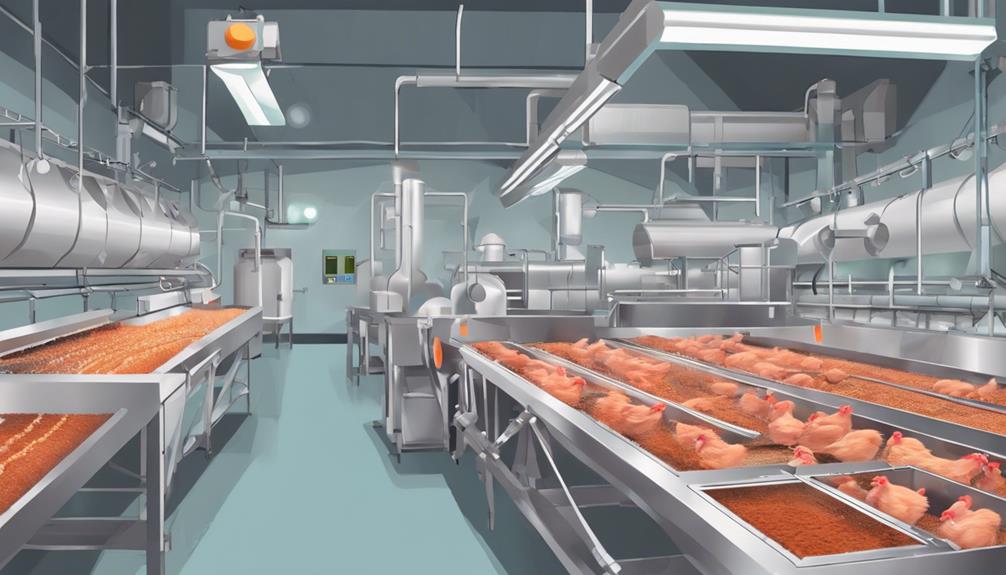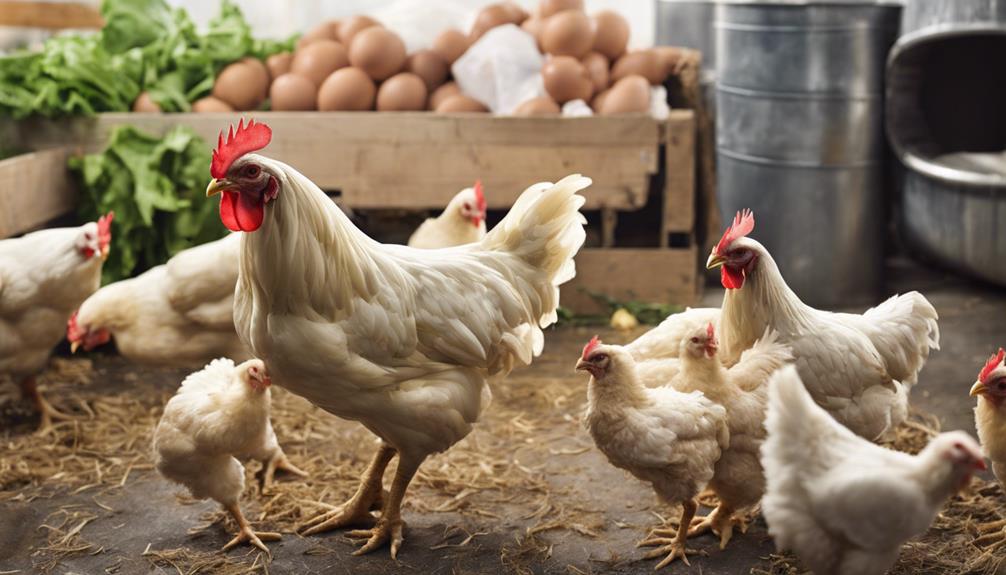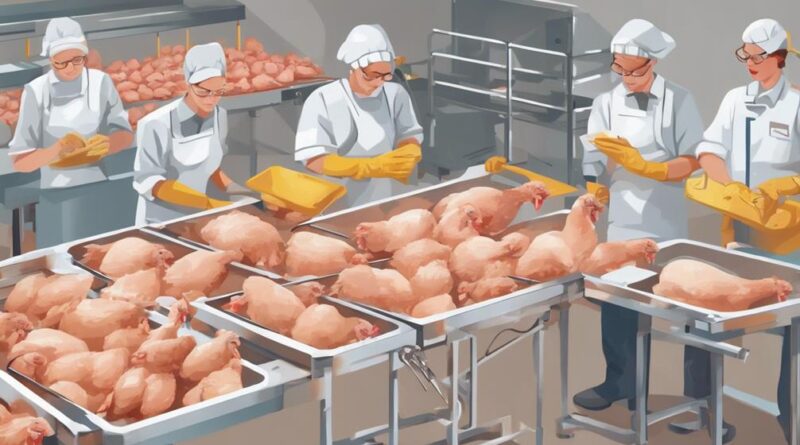Top 10 Safety Standards in Chicken Product Processing"
When it comes to chicken product processing, ensuring adherence to the top 10 safety standards is paramount. From the proper use of personal protective equipment to stringent sanitation practices, each standard plays a crucial role in maintaining the integrity of the final products. The significance of hazard analysis, employee training, equipment maintenance, and regulatory compliance cannot be overstated. As you contemplate the complexities of these safety standards, you'll soon realize the intricate web of precautions necessary to uphold the highest levels of safety and quality in chicken processing facilities.
Proper Personal Protective Equipment (PPE)
When handling chicken products in the processing plant, wearing the appropriate Personal Protective Equipment (PPE) is essential to ensure worker safety and hygiene standards are met. PPE plays a crucial role in safeguarding employees from potential hazards in the workplace. The effectiveness of PPE is directly related to how well it's selected to match the specific risks present in the chicken processing environment.
PPE effectiveness is contingent upon proper selection based on industry standards. Different tasks require different types of PPE to mitigate specific risks adequately. For instance, workers handling sharp tools may need cut-resistant gloves, while those working with chemicals might require goggles and aprons. Ensuring that the PPE meets industry standards is vital to providing the necessary level of protection for workers.
Moreover, workplace comfort is a significant factor when it comes to PPE. Uncomfortable or ill-fitting equipment can lead to workers avoiding wearing it altogether or not using it correctly. This can compromise their safety and the overall hygiene standards of the processing plant. Therefore, selecting PPE that not only meets safety requirements but also considers the comfort of the workers is crucial for maintaining a safe and productive work environment.
Sanitation and Hygiene Practices
Maintaining strict sanitation and hygiene practices is paramount in ensuring the safety and quality of chicken products during processing. Handwashing practices play a crucial role in preventing cross-contamination and ensuring food safety. Employees must wash their hands thoroughly and frequently, especially after handling raw chicken or moving between different work areas.
The facility layout is instrumental in promoting sanitation. Designing the processing plant with separate zones for different tasks, such as packaging and raw processing, helps minimize the risk of contamination. Implementing a rigorous cleaning schedule is essential to prevent the buildup of bacteria and pathogens. Regularly sanitizing equipment, work surfaces, and utensils reduces the chances of microbial contamination.
Furthermore, establishing clear protocols for cleaning and sanitation procedures is vital. Employees should be trained on the proper use of cleaning agents and sanitizers to maintain a hygienic environment. Regular inspections and audits can help ensure that sanitation practices are being followed consistently.
Hazard Analysis and Critical Control Points (HACCP)
Implementing Hazard Analysis and Critical Control Points (HACCP) is essential for ensuring the safety and quality of chicken products during processing. HACCP implementation involves a systematic approach to identifying and controlling food safety hazards throughout the production process. By following established food safety protocols, you can minimize risks and uphold high standards in chicken product processing.
- Identifying Critical Control Points (CCPs): In HACCP implementation, it's crucial to pinpoint the stages in the production process where control measures are essential to prevent, eliminate, or reduce potential hazards.
- Establishing Critical Limits: Once CCPs are identified, setting critical limits is necessary. These limits are the criteria that must be met to ensure the food product is safe for consumption.
- Implementing Monitoring Procedures: Regular monitoring at CCPs is vital to verify that the process is under control. This step helps in detecting any deviations from the critical limits promptly.
Employee Training and Education
To ensure the highest standards of safety and quality in chicken product processing, thorough training and education of employees are imperative. Effective onboarding processes play a crucial role in introducing new employees to safety protocols, quality standards, and operational procedures within the processing facility. These processes ensure that all staff members are equipped with the necessary knowledge and skills to perform their roles safely and efficiently from the start.
In addition to initial training, continuous improvement is key in enhancing employee competence and awareness. Regular skill development programs not only help employees refine their existing abilities but also introduce them to industry updates, new technologies, and best practices in chicken product processing. By staying informed about the latest trends and regulations in the industry, employees can adapt quickly to changes, contribute to a culture of safety, and uphold the highest standards of quality in their work.
Investing in employee training and education not only fosters a culture of excellence within the processing facility but also ensures that staff members are well-prepared to handle challenges and opportunities in the dynamic environment of chicken product processing. Prioritizing skill development and staying updated on industry advancements are essential components of maintaining a competent and knowledgeable workforce.
Equipment Maintenance and Safety Checks
Regular inspections and upkeep of equipment are essential for ensuring optimal safety standards in chicken product processing. To maintain a safe working environment, follow these key steps:
- Equipment Inspection: Conduct regular inspections of all machinery and tools used in the processing line. Look for any signs of wear and tear, loose components, or potential hazards. Address any issues promptly to prevent accidents or malfunctions.
- Safety Audits: Implement routine safety audits to evaluate the effectiveness of safety measures in place. These audits help identify areas of improvement and ensure compliance with safety regulations. Make necessary adjustments based on audit findings to enhance overall safety.
- Maintenance Protocols: Establish clear maintenance protocols for all equipment. Create a schedule for routine maintenance tasks such as lubrication, cleaning, and calibration. Adhering to maintenance protocols prolongs the lifespan of equipment and reduces the risk of unexpected breakdowns.
Regular equipment inspections, safety audits, and maintenance protocols are crucial components of a comprehensive risk assessment strategy. By prioritizing equipment maintenance and safety checks, you contribute to a safer work environment and minimize the likelihood of accidents or operational disruptions. Remember, proactive maintenance is key to upholding safety standards in chicken product processing.
Cross-Contamination Prevention Measures
To maintain the integrity of your chicken products and uphold food safety standards, meticulous attention to cross-contamination prevention measures is imperative in the processing environment. Allergen control and equipment separation are key aspects of preventing cross-contamination. It's crucial to have designated areas for handling different allergens and to ensure that tools and equipment are thoroughly cleaned and sanitized between uses to avoid any potential transfer of allergens from one product to another.
Moreover, maintaining packaging integrity is essential in preventing cross-contamination. Properly sealed and labeled packaging helps to safeguard products from external contaminants and ensures that the contents remain uncontaminated throughout the processing and distribution chain. Regular checks and quality control measures should be in place to guarantee that packaging materials meet industry standards and aren't compromised during handling or storage.
In addition to allergen control and packaging integrity, effective pathogen control measures are vital for preventing cross-contamination in chicken product processing. Comprehensive sanitation protocols, including disinfection of surfaces, equipment, and utensils, are necessary to eliminate any harmful pathogens that could contaminate the products. Implementing strict hygiene practices and conducting regular testing for pathogens can help mitigate the risk of contamination and uphold the safety and quality of chicken products.
Temperature Control and Monitoring

Maintaining precise temperature control and implementing rigorous monitoring procedures are essential components of ensuring the safety and quality of chicken products during processing. To achieve this, consider the following:
- Cooling processes: Proper cooling processes are crucial in preventing bacterial growth and maintaining the freshness of chicken products. Implementing rapid cooling methods after cooking helps to minimize the time that the chicken spends in the temperature danger zone, which is between 40°F and 140°F, where bacteria can multiply rapidly.
- Monitoring: Continuous monitoring of temperatures at various stages of processing is necessary to ensure that chicken products are kept at safe temperatures. Utilize temperature monitoring devices such as thermometers and data loggers to track temperatures accurately. Regularly calibrate these devices to maintain their accuracy.
- Food safety guidelines: Adhere to food safety guidelines set forth by regulatory bodies to ensure that temperature control measures meet industry standards. Familiarize yourself with the specific temperature requirements for different types of chicken products and processing methods. Regularly review and update your temperature control procedures to align with the latest food safety regulations.
Emergency Response and Preparedness
Ensure a robust emergency response and preparedness plan is in place to swiftly address any potential safety hazards or incidents that may arise during chicken product processing. Conduct regular emergency drills to train employees on proper procedures in case of emergencies. Effective communication is key during emergencies; establish clear communication channels and protocols to ensure seamless coordination among all staff members.
In the event of an incident, have a well-defined incident response plan outlining roles, responsibilities, and steps to be taken. Designate specific personnel to lead the response efforts and coordinate with emergency services if necessary. Regularly review and update the emergency response plan to account for any changes in operations or new potential hazards.
Ensure that all employees are familiar with the emergency response plan through training sessions and information dissemination. Encourage a culture of vigilance and preparedness among all staff members to enhance overall safety in the processing facility. Practice coordination with local emergency services to streamline response efforts and improve overall effectiveness.
Waste Management Procedures

Implementing efficient waste management procedures in chicken product processing facilities is crucial for maintaining cleanliness and minimizing environmental impact. Proper waste handling not only ensures a hygienic workspace but also reduces the ecological footprint of the operation.
To achieve these goals, consider the following strategies:
- Waste Reduction Strategies: Implementing waste reduction strategies such as optimizing production processes to minimize byproducts can significantly decrease the amount of waste generated. This can include utilizing more of the chicken during processing or finding alternative uses for byproducts.
- Recycling Initiatives: Setting up recycling initiatives within the facility can help divert materials from landfills. This can involve segregating waste streams like plastics, cardboard, and organic waste for recycling or composting.
- Waste Disposal Techniques: Proper waste disposal techniques are essential to prevent pollution and contamination. Ensure that hazardous waste, such as chemicals or oils used in processing, is disposed of following regulations. Additionally, organic waste should be managed properly to avoid attracting pests and causing odors.
Regulatory Compliance and Audits
Adhering to regulatory standards and undergoing regular audits is paramount in ensuring the safety and quality of chicken products processed in facilities. Food safety audits play a crucial role in verifying that processing plants comply with the established regulations. These audits are conducted by trained inspectors who evaluate various aspects of the facility's operations to identify any potential risks to food safety.
Regulatory standards set by governmental bodies outline the requirements that chicken processing facilities must meet to guarantee the production of safe products. These standards cover a wide range of areas, including hygiene practices, equipment maintenance, employee training, and record-keeping procedures. Regular inspections are carried out to assess whether the facility is operating in accordance with these standards.
During inspections, auditors review documentation, observe processes, and interview staff to ensure compliance with regulatory requirements. Any deviations from the standards are documented, and corrective actions are mandated to address non-compliance issues promptly. By adhering to these regulatory standards and promptly addressing any deficiencies identified during audits, chicken processing facilities can uphold the highest levels of food safety and quality in their products.
Frequently Asked Questions
How Often Should Employees Undergo Refresher Training on Safety Protocols?
You should ensure that employees undergo refresher training on safety protocols regularly. This practice helps reinforce critical safety measures and keeps everyone informed of any updates or changes.
What Measures Are in Place to Prevent Unauthorized Access to Processing Areas?
To prevent unauthorized access to processing areas, access control measures are crucial. Security protocols like keycard entry systems, biometric scanners, and security personnel monitoring entry points help maintain a secure environment.
Regularly updating access codes, restricting entry to authorized personnel only, and conducting periodic security audits enhance the effectiveness of these measures.
Are There Specific Protocols for Handling Chemical Spills in the Facility?
When it comes to handling chemical spills in the facility, specific protocols are crucial. Ensure that all staff members are trained on the proper chemical spill response procedures.
Regularly check and maintain safety equipment to guarantee it's ready for immediate use in case of a spill. By adhering to these protocols and keeping safety equipment in top condition, you can effectively mitigate risks associated with chemical spills in the facility.
How Are Safety Audits Conducted to Ensure Compliance With Regulations?
To conduct safety audits and ensure compliance with regulations, your facility implements thorough inspection processes. Audits involve examining all aspects of operations to identify any potential safety risks or violations.
Compliance monitoring is carried out regularly to confirm adherence to industry standards and regulations. By conducting these audits meticulously, your facility maintains a high level of safety and regulatory compliance, ensuring a secure environment for all employees and consumers.
What Emergency Response Drills Are Practiced Regularly by Employees?
Incorporating emergency response and evacuation procedures into your training regimen ensures that employees are well-prepared for any potential crises. Regular drills help you practice proper protocols and familiarize yourself with evacuation routes.
Conclusion
In conclusion, adherence to the top 10 safety standards in chicken product processing is crucial for maintaining high levels of safety, hygiene, and product quality.
By ensuring proper PPE usage, sanitation practices, HACCP implementation, employee training, equipment maintenance, temperature control, emergency preparedness, waste management, and regulatory compliance, chicken processing facilities can create a safe and efficient working environment while producing top-quality products for consumers.
Following these standards diligently is key to success in this industry.
